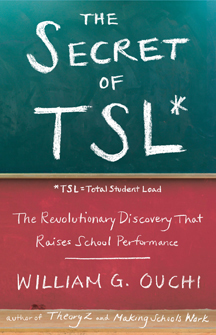 The Secret of TSL: ?The revolutionary discovery that raises school performance
The Secret of TSL: ?The revolutionary discovery that raises school performance
By William G. Ouchi
Simon and Schuster, 2009, $26; 336 pages.
When I first saw the title, never having heard of TSL, I thought this might be a late-night infomercial about a new diet supplement designed to make all students attentive. Not far into the book, I discovered that TSL was Total Student Load, which, unfortunately, did not help me very much. Then to the hypothesis on the cover: The key element of a school’s organization is the number of students that a teacher regularly sees (TSL), and if this number is small (say, 80), achievement will be high.
The hypothesis is really an assertion based on a vaguely described analysis. And while it is a discernible undercurrent throughout the book, TSL is not the volume’s central feature. The book presents a series of case studies of large, and distinctly nonrandom, districts. Within those case studies, the focus is twofold: decentralization of decisionmaking and the quality of the superintendent. The book provides an in-depth look at districts that have in one way or another followed the advice given in one of Ouchi’s previous books, about the benefits of weighted student funding, whereby schools receive funds based on the make-up of their student populations, and decentralized decisionmaking. This book includes additional observations of schools where the principles of fiscal decentralization are evident.
What is good and interesting about The Secret of TSL? Ouchi traces the evolution of district policies under several high-profile leaders—Joel Klein (New York), Arne Duncan (Chicago), Arlene Ackerman (San Francisco), Rod Paige (Houston), Randy Ward (Oakland), Pat Harvey (St. Paul)—whose stories are both compelling and informative. The perspective is that of a management professor, one trained in understanding decisionmaking styles and models and the interactions of institutions and individuals. This approach is one not commonly taken by education researchers, who more often focus on what is happening in classrooms and the interactions between students and teachers. Here, an experienced observer looks at the overall structure of how education is produced. The higher-altitude view is both useful and intriguing.
The story line that emerges, perhaps unintentionally, is that the individual leaders have very different views about how to organize and run schools. No one would accuse Randy Ward of having the same style as Arlene Ackerman, even though they were for a time separated only by the Bay Bridge. Indeed, almost as an aside to the title page, the districts that are described in detail follow very different policies that lead to wholly different TSL measures.
What does not work in the book? Well, start at the beginning. There is no sense in terming TSL a “revolutionary discovery.” While TSL is calculated in each of the case studies, there is no evidence that the measure is correlated with overall district performance or district growth in achievement. In fact, the “revolutionary discovery” looks more like a required element of a standard management book aimed at the New York Times best-seller list. In the tradition of that genre, there are two numbered lists: the “five pillars” of school empowerment and the “four freedoms.” These lists largely drop out of the sky except that some of the included items appeared in Ouchi’s earlier “revolutionary” book, Making Schools Work: A Revolutionary Plan to Get Your Children the Education They Need. In actuality, the lists are not bad: choice, school empowerment, effective principals, accountability, and weighted student funding matched with control over budget, staffing, curriculum, and scheduling. But there is little explanation about how these notions are implemented, what impact might be expected, and what the trade-offs among the elements might be. In the separate case studies, the leaders sometimes pay attention to the elements on these lists, and sometimes do not, and it is hard to see that those who heed the lists do better than those who do not.
In the end, it is difficult to tell whether the story is about some gifted leaders or about decentralized authority and specific programs. At this point, the case study methodology breaks down, because it is impossible to separate structure and institutions from personality.
But, returning to TSL, the argument is compelling in an intuitive sense. How can one expect a teacher to really get to know 150 different students during a year? How can a teacher possibly assign regular and demanding homework to such large numbers if it is necessary to review and grade all the assignments?
There are, however, some crucial issues of interpretation that beg for serious empirical analysis. For example, the discussion leaves out whether TSL is expected to have an impact while all other things are held constant, such as budget, teacher expertise, curriculum, and support services, to name a few. Or, does it enhance achievement to trade some of these attributes for a smaller TSL? It would be particularly valuable to marry these organizational views with separate analyses of teacher effectiveness. Current discussions of the importance of teacher quality for achievement generally ignore such environmental features as district management and decisionmaking. Could it be that some of the observed variation in teacher quality really reflects unmeasured differences in the organizational features that Ouchi highlights in his case studies? These are testable propositions, and ones that could provide important insights into where the revolution in student achievement is most likely to occur.
Eric Hanushek is senior fellow at the Hoover Institution of Stanford University and a member of the Koret Task Force on K–12 Education.


